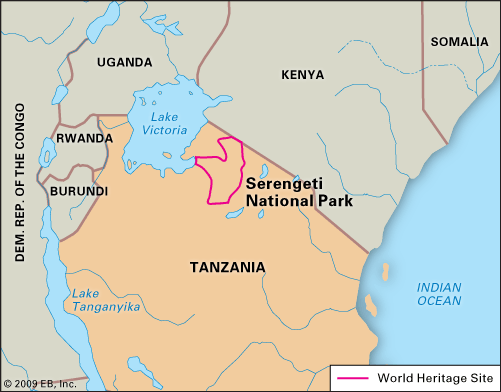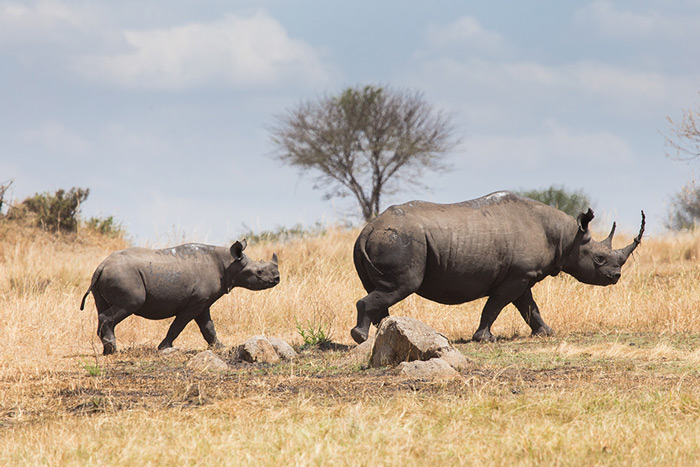The size of Serengeti national park

The size of Serengeti national park : Serengeti national park is one of the finest national parks in world and a national park in Tanzania renowned for its mind blowing population of wildlife and impressive landscape, the park is also famous for the great wildebeest referred to as “the wildlife world camp”. The great wildebeest migration is the greatest wild life migration in the world in which 1.5 million wildebeests, over 250,000 zebras and gazelles migrate from Serengeti national park to Maasai Mara national reserve in search for pasture and water.
Serengeti national park lies in the Serengeti ecosystem consisting of Mara and Simiyu regions, Serengeti national park covers an area of 14,750 square kilometers and is the centerpiece of the ecosystem. The park is twice as large as Ngorongoro conservation area and Maasai Mara national reserve combined in size. Serengeti national park is dominated by grassland plains, savanna, riverine forests and woodlands.
Geographically, Serengeti national park lies in the northwestern Tanzania bordering the Kenyan border to the north at the point where it is continuous with Maasai Mara national reserve, Ngorongoro conservation area to the southeast, Maswa game reserve to the southwest, Ikorongo and Grumeti game reserves to the west and Loliondo and Grumeti control area to the northeast and east.

Region of Serengeti national park
Southern Serengeti
Southern Serengeti is a fascinating and one of the most visited regions of the Serengeti national park comprising of Ndutu area, Lake Ndutu and Naabi Hill, this regions lies close to Ngorongoro crater and Olduvai Gorge which are remarkable tourist attractions in Tanzania. In the southern Serengeti, Ndutu region is the most popular part of the region famous for being a home to the wildebeest migration and its calving season.
The southern Serengeti is endowed with flat, open plains covered with savannah grasslands and dotted with granite Kopjes, there is also Lake Ndutu also Known as Lagarja which is surrounded by beautiful acacia trees. Lake Ndutu attracts a good population of animals which come to the lake to drink water and is an amazing site for birdlife with incredible flocks of pink flamingoes.
The southern Serengeti hosts the calving season of wildebeest migration where over 8,000 baby wildebeests are born each day and predator action is sighted as predators attack the babies for easy meal. There are a variety of animals found in this region and these include wildebeests, leopards, lions, cheetah, giraffe, elephants, caracal, hyenas, jackal, giraffes, elands and many more.
Western Serengeti
Western Serengeti commonly known as the western Corridor is a beautiful region consisting of Grumenti and Ikoma areas, the western Serengeti is the starting point for the great wildebeest migration’s river crossings.
The Western Serengeti’s landscape is hilly, wooded and dotted with large forests of acacia and an endless terrain, this region is a home to many predators such as lions, cheetahs, leopards and hyenas. Other animals sighted in the western corridor/western Serengeti include Nile crocodiles seen along Grumeti river, black and white colobus monkeys, Patas monkeys, impalas, topi, reedbuck, waterbuck, coke’s hartebeests, roan antelope, buffalo, elephants and many more.
Central Serengeti
Central Serengeti is the heart of Serengeti national park and one of the best regions of the park for game viewing experience any time of the year, central region is also referred to as Seronera area/region. The central region is famously known for hosting the most number of lodges in Serengeti national park and best for hot air balloon safaris.
Central Serengeti consists of a diverse ecosystem made up of grasslands, acacia forests and riverine areas. There is also the famous Retina Hippo Pool in the northern region of the Seronera River Valley, this site is a waterhole inhabited by a huge number of hippos where tourists get to enjoy watching hippo action.
Central Serengeti region of Serengeti national park inhabits a variety of animals such as hippos, giraffes, antelopes, elephants, zebras, lions, leopards, cheetahs and many more. Seronera/central Serengeti consists of Seronera airstrip handling domestic flights to the region and to Serengeti national park as a general.
Northern Serengeti
Northern Serengeti is a popular region of Serengeti national park made up of Kogatende and Lobo areas and comprising of Bologonja Gate, Sand River gate, Sekenani gate, Klein’s gat, Lobo airstrip and Kogatende airstrip. The northern region of Serengeti national park is crossed by the wildebeest migration during the famous river crossing and because of this the region consists of numerous seasonal camps and lodges hosting travelers who visit the park to watch the migration.
Northern Serengeti is made up of a scenic landscape consisting of hills, riverine forests, plains and rocky outcrops. The region is crossed by Mara River which is crossed during the great wildebeest migration as animals (wildebeests, zebras, Thomson and grant’s gazelles) migrate to Maasai Mara national reserve.
Northern Serengeti is considered as the most quite region of Serengeti national park and it is famous for hosting a huge number of cheetahs and it is one of the best places to see them in Africa.
In conclusion> Serengeti national park covers an area of 14,750 square kilometers in size.


